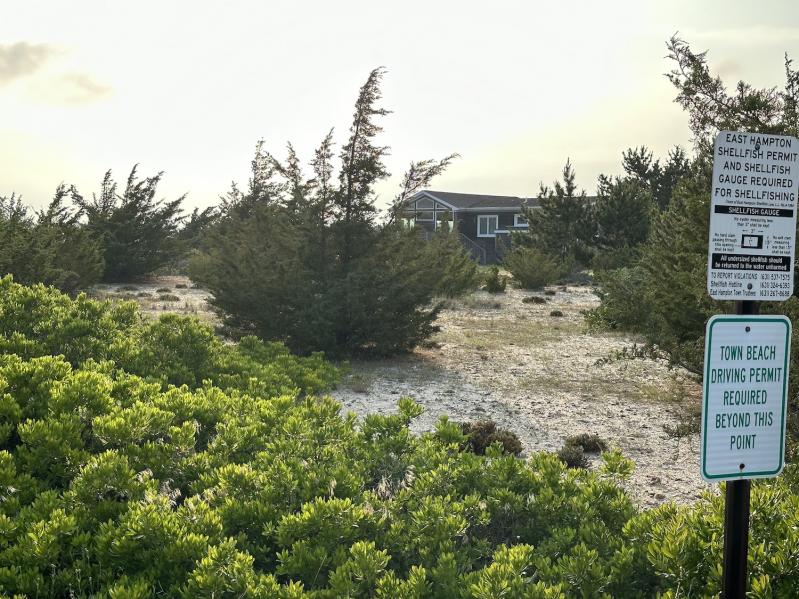In recent months, judges have twice overturned East Hampton Town Zoning Board of Appeals decisions regarding natural resources special permits and that could have significant ramifications moving forward, as the town zoning code gets chipped away by the Suffolk County Supreme Court.
In March, Justice Christopher Modelewski sided with Dante Brittis, after the zoning board denied his application for a natural resources special permit and wetland setback variances to renovate and expand his house at 330 Gerard Drive. Then in May, Justice James F. Quinn ruled in favor of John McGinn and Cary Davis, who own a house at 275 Three Mile Harbor Road and had been denied a natural resources special permit to build a dock. A new dock had not been approved in the area for over 35 years.
In both cases the judges ruled that the Z.B.A. acted in an arbitrary manner and without evidence supporting its claims that the applications, if approved, would negatively affect the environment. While the town appeals both rulings, should they ultimately stand, a huge burden would be placed upon the town’s Planning Department to prove, with evidence, that a certain action by a homeowner would cause environmental harm.
According to the Planning Department, approximately 75 percent of applications contain a natural resources special permit component, which means applicants are requesting a change within 150 feet of wetlands.
When a natural resources special permit application get turned down, a homeowner has 30 days to appeal. It’s possible, given these two recent cases, that the town could see an avalanche of appeals come its way at a moment when it is already facing an eight-month backlog on applications partly because of a short-staffed Planning Department.
The office of the town attorney is having its own staffing issues as well. Hope DeLauter, an assistant town attorney, recently resigned, and John Jilnicki, a town attorney with close to 40 years of experience as a municipal lawyer for the town, retired from that role at the end of May.
Dante Brittis’s family has owned the house at 330 Gerard Drive for over 50 years. The 1,330-square-foot house was built in 1971, before East Hampton Town or the State Department of Environmental Conservation had regulations regarding tidal wetlands. The family’s attorney, Andy Hammer, argued before the Z.B.A. at a May 17, 2022, public hearing that the Brittis family had been model stewards.
“I can’t think of any applicant that has been in front of this board with this type of history,” said Mr. Hammer. “They’re not some ‘Johnny-come-lately’ developer looking for a quick renovation to add to their portfolio.” He also argued that the renovation, which would add 500 square feet to the second floor, but not extend beyond the current footprint of the home, was “as modest an application that I think can be made.”
As mitigation, they offered to install an up-to-date septic system to replace an aging brick cesspool that was negatively affecting the nearby wetlands. When Roy Dalene, the chairman of the Z.B.A, said that the biggest problem for him was that the renovation would change the character of the neighborhood, Mr. Hammer argued that “the most identifiable character of the neighborhood is this house. It’s been there the whole time.” Upgrading the sanitary system, he said, was the single most important thing they could do to maintain the character of the neighborhood.
Brian Frank, the chief environmental analyst for the town, argued otherwise. He said the town had a history of strictly applying the natural resources special permit standards for houses along Gerard Drive and said it would not matter if the applicant was a new homeowner, since the board could not take the owner of a property into consideration. The biggest problem, he said was that the parcel had no conforming building envelope.
“The recommendations are based on the constraints of the property and the standards of the town code. The I/A system by itself cannot be used as leverage to offset the scale of development that doesn’t fit the constraints of the property, and that’s really the issue with this application,” Mr. Frank said.
Two members of the public spoke out against the addition, and a letter of opposition was sent to the Z.B.A. In response, the Brittis family cut the size of the second story 20 percent, but nonetheless, on Sept. 13, the Z.B.A. unanimously voted against the application.
Justice Modelewski was practically scolding in his ruling. “The town’s chief environmental analyst waxed on at great length about the environmental sensitivity of the area, including a number of designations (Critical Environmental Area, Important Bird Area, et cetera), without explaining how the modest addition as proposed would adversely affect other properties in the area or manifest some harm to the environment. Even worse is the short shrift given by the Board to that aspect of the petitioner’s plans that included replacement of a fifty-year-old block cesspool with a state-of-the-art system designed to mitigate nitrogen migration into the surrounding tidal waters,” he wrote.
Neither Mr. Frank, citing the pending litigation, nor Jeremy Samuelson, the planning director for the town, were able to comment. Robert Connelly, the new town attorney, was on vacation and could not be reached for comment.
The case of the dock at 275 Three Mile Harbor Road was different, in that it did not involve improvements to a residence but similar in that a natural resources special permit was required. Justice Quinn was unimpressed by the town’s argument that a new dock had not been constructed in 35 years, saying that in the 1980s docks were banned in all waterways owned by the town’s trustees “except the east side of Three Mile Harbor where this property sits with a preexisting number of commercial and residential docks.”
As in the Brittis case, Justice Quinn found Mr. Frank’s testimony supporting the zoning board’s denial of the permit for the dock insufficient. “Any of his commentary was general and non-specific,” he wrote. Basically, he said that, if the town didn’t want new docks in Three Mile Harbor, it lost their chance when the town trustees gave approval to the McGinn dock in October 2021.
“The Court finds that the Board’s decision is in effect its desire to have a complete moratorium of dock building in its waters, which it has the authority to do upon proper legislation, however this court finds that its instant decision was arbitrary and not supported by the presented evidence in this case.”
What both cases demonstrate is that judges are no longer giving the town a pass on providing hard evidence before it turns down an application. Lawyers advocating for their clients could pay for expert witnesses who might find no specific environmental harm and the burden would fall on the town to prove otherwise. Local land use attorneys are paying attention.
Speaking at a Z.B.A. hearing on an application for 50 Oyster Shores Road on Tuesday night, Jon Tarbet, an attorney representing the homeowners, referenced the Brittis decision directly. He said the Planning Department, in criticizing the application, seemed more focused on aesthetics. “They should spend more time looking at whether it’s a net benefit or net detriment,” he said. “We’re only here for a wetland variance. More frequently the judges in Riverhead have been saying that if you meet the standards, you should be given the permit.”
“Jon is 100 percent wrong,” Mr. Frank said at the meeting on Tuesday. “Our wetlands setbacks, and our N.R.S.P. regulations, are part of zoning. They are a part of the standards that development on this lot has to meet. So, when John says it meets all standards, the fact that they meet front-yard setbacks, and pyramid, and side-yard setbacks, doesn’t mean that they meet the standards for the granting of the wetland variances, and it doesn’t mean they meet the standards of the N.R.S.P. It’s not the Planning Department’s responsibility to point out how this is bad for the environment; it’s the applicant’s obligation to point out how an application meets the variance standards. And nowhere in the variance standards does it say if what you’re proposing is better than what’s there, now you meet the variance standards. Jon’s characterization really shows a fundamental lack of understanding of what zoning is.”
The town is appealing both the Brittis and McGinn decisions.




